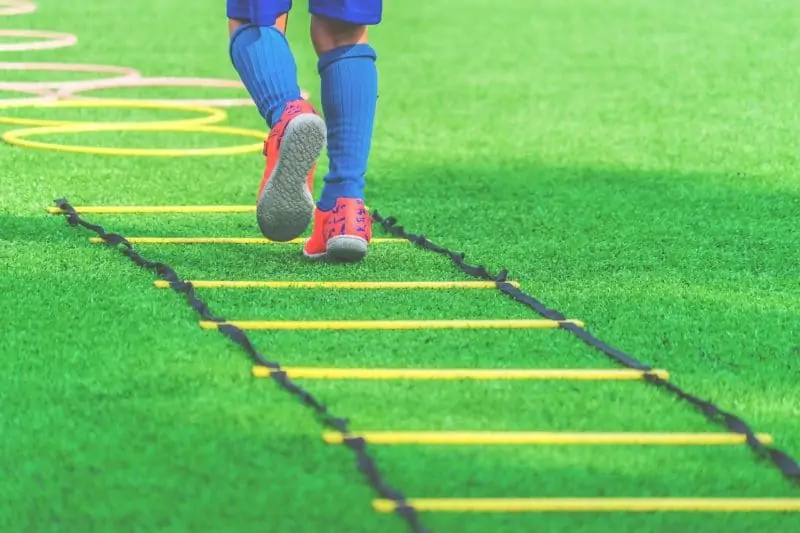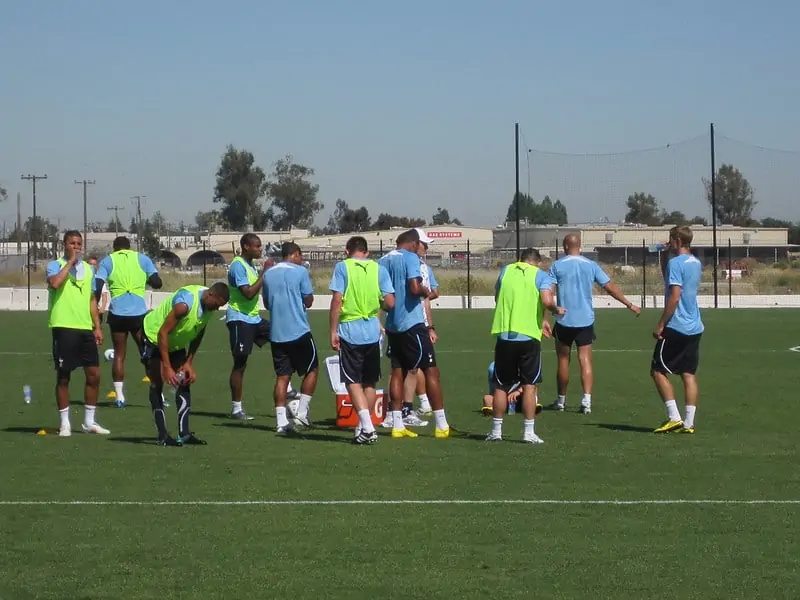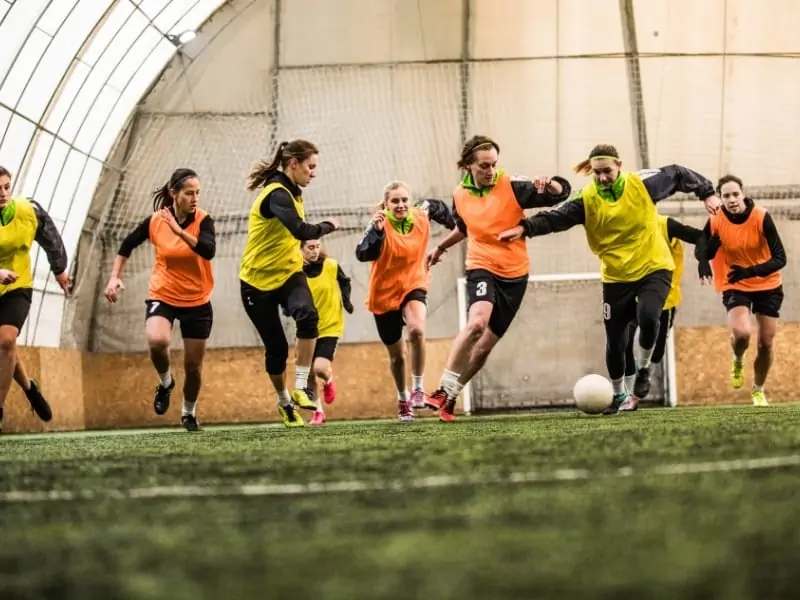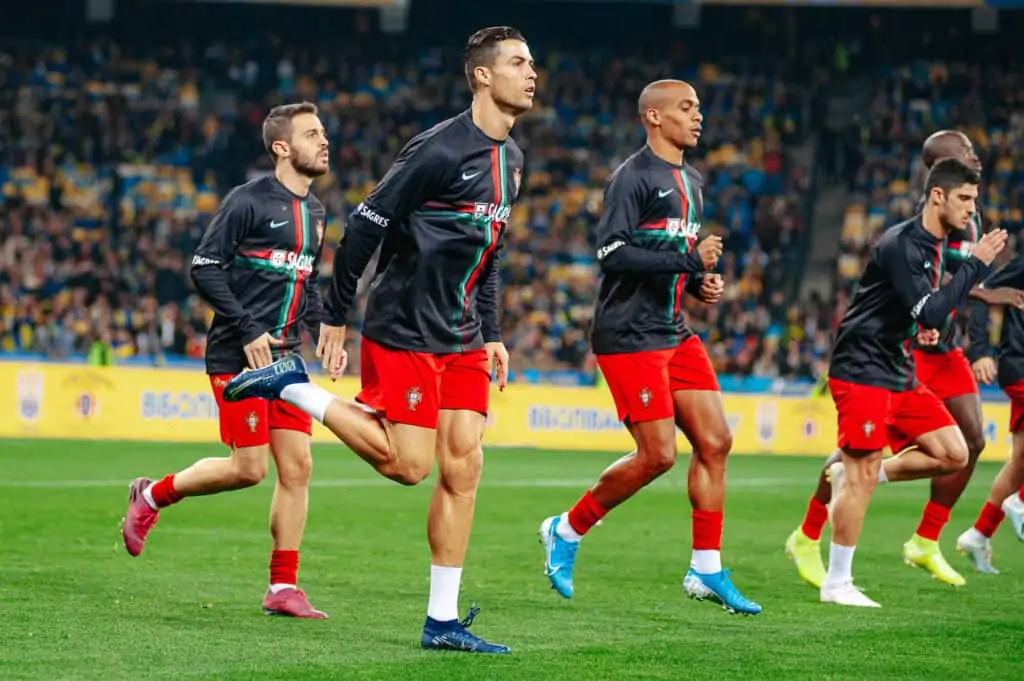Share the post "How Often Do Soccer Players Train? (Pain and Gain)"
Have you ever wondered what it takes to train like a professional soccer player? Could you meet the daily, weekly, and yearly demands of a pro soccer player?
I’ve often wondered about this, primarily upon hearing about multi-million dollar transfers involving high-profile players.
After 90 minutes, you start to feel the strain and aches you feel the day after, but how do they do it?
Consider what a pro’s schedule entails and how often soccer players actually train.
Does their workload really reflect the tens of millions that they earn every year? I decided to take a look – you’ll know as a pro at the end.

How often do professional soccer players train?
During the pre-season and regular season, players train up to 30 hours per week. Training schedules can vary significantly depending on the time of year.
The off-season can be only 2-3 weeks per year, and this is a recovery period with light training.
The calendar year is split into 3 seasons for a pro soccer player:
- Pre-Season
- Regular Season
- Off-Season
Here’s a combined training kit that will help you get up to speed;
- 【Agility Training Equipment Kit】 The Most complete speed…
- 【Suitable for People of all Ages】The agility ladder…
- 【Awake Your Potential】 Our agility ladder training…
- 【Extra Perks with Bag & Guides】Everything in this…
- 【100% Satisfaction Guaranteed】EAZY2HD soccer training…
Product: Updated 2024-07-19 | Images: Amazon Product Advertising API | #ad – soccerblade.com is an Amazon Associate
Running
When comparing running statistics in different sports, Runnersworld reported that soccer players cover a whopping 7 miles in every game.
This involves a combination of frequent small movements, short and long sprints, and jogging over a 90-minute game.

Throw in tackles, shooting, and jumping, amongst other dynamic movements, and we can begin to see how physically exhausting the sport can be.
The ability to do this regularly (sometimes twice or three times per week), over a full season requires a supreme fitness level.
Let’s look at how often soccer players train and what exactly they do to stay fit, maintain, and improve their skill level, and prepare for games.
Soccer Training Gear






Product: Updated 2024-07-19 | Images: Amazon Product Advertising API | #ad - soccerblade.com is an Amazon Associate
Training Schedule
*For the purpose of this article, we’ll look at the yearly schedule followed by the top European leagues.
Pre-Season Training
Pre-season training is intense, frequent, and requires extra recovery sessions. It starts out light but builds towards heavy workloads involving tonnes of running.
The purpose of this is to reach maximum fitness levels whilst keeping the risk of injury as low as possible.
Players can train up to 3 times per day. Towards the end of the pre-season, the focus of the sessions is more soccer-oriented.
Training must incorporate skill development, as well as laying the foundations for what tactical approach will be deployed during the season.
Here is a look at one of Liverpool’s pre-season training sessions during their USA tour last summer.
Note; the different aspects focused on during the session and the varying intensity levels.
Training Timetable
| Monday | Tuesday | Wednesday | Thursday | Friday | Saturday | Sunday |
| Meeting | Meeting | Meeting | Meeting | Meeting | Game | Recovery |
| Warm-Up | Warm-Up | Team Training | Warm-Up | Warm-Up | Game | Recovery |
| Specialized Training (e.g. speed) | Specialized Training | Recovery Session | Specialized Training | Team Training | Game | Recovery |
| Gym Sessions | Gym Sessions | Gym Session | Game | Recovery | ||
| Lunch | Lunch | Lunch | Lunch | Lunch | Game | Recovery |
| Team Training | Team Training | Team Training | Game | Recovery | ||
| Extra Training | Game | Recovery |
Here’s a simplified example of apre-season weekly plan, based on an article from Football Medicine.
Regular-Season Training

A typical day does not necessarily exist in the life of a pro soccer player. Training days vary depending on the time of year or when the next game will be played.
When there’s no midweek game, a team will generally spend Monday to Friday preparing for their match on Saturday or Sunday.
Sessions earlier in the week are focused on recovery from the previous game. Midweek training is more intense with sessions focusing on strength, speed, and skill work.
Intense training eases up and takes a tactical turn as game day nears.
Training Schedule
Players usually train in the morning and after lunch. Morning sessions generally involve warm-ups and muscle activation, speed and agility work, team training, and gym work.
This is followed by much-needed refueling (lunch!).
Although a soccer player’s day is broken up into several stages, there are 2 main training sessions per day – morning and afternoon.
Including game days, players will normally train 5 to 6 days per week. Teams rarely train heavily on travel days.

Off-Season Training
Off-season training comes down to the individual. It’s become commonplace for players to hire a personal trainer and even a chef or nutrition expert to travel with them on vacation.
The majority of pros make a concerted effort to stay fit and healthy, even in their downtime.
This is a far cry from the days of old when players would get notoriously out of shape, reportedly overindulging in food and alcohol!
- The off-season is now looked at as a time for players to boost their fitness levels, increase strength, and prepare for the season ahead.
Players’ Instagram accounts are filled with snippets of their off-season workouts.
Although many of these sessions take place in exotic locations, the dedication and commitment of most pro players cannot be questioned!

Rest and Recovery After Training
Something that’s constantly overlooked in the modern game is the emphasis placed on rest and recovery.
Failure to implement the correct recovery techniques between sessions and games can increase the risk of injury and cause performance dips.
We’re seeing players perform at peak levels much later in their careers. Cristiano Ronaldo, at 34 years of age, has yet to start his decline.
Zlatan Ibrahimovic is continuing to dominate in the MLS deep into his 30s.

The latest sports science plays a contributing factor to this trend. Its influence on the game is at an all-time high.
Players at every level are accustomed to strict nutrition plans, ice baths, and physical therapy sessions to aid their recovery and maximize performance.
Sleep is a topic of sports science that’s created waves across all sports recently, particularly in soccer.
Sleep Recovery
In some instances, sleep is now regarded as being equally as important to a player’s recovery as nutrition and physio treatments.
Not only does sleep have an effect on recovery, but it also has a big impact on mental and physical performance.
Lebron James is said to spend $1.5 million dollars per year on his training, nutrition, and recovery routine. He places a huge emphasis on his rest and famously stated that sleep is;
“…the best recovery that you can possibly get.”
Lebron James
James claims to get up to 10 hours per night in order to be at his best on the court.
Andre Iguodala made huge changes to his sleeping habits in 2013 upon joining the Golden State Warriors.
- His stat lines showed improvements as a result, and he’s since gone on to pick up 3 rings and a Finals MVP trophy.
Pro soccer players in the modern era spend a lot of their time “sleeping their way to the top”, as reported by the BBC.
Soccer Players’ Bedrooms
Manchester City is even said to have 32 en-suite bedrooms at their headquarters for post-training snoozes.
At the famous ‘Valdebebas’, Real Madrid players take a 2-hour siesta between morning and afternoon sessions.
As crazy as that sounds, it’s standard for pro teams to have resting facilities and individually adapted sleeping programs for players.
Fractions of percentages are what make an impact at the highest level: teams and players are always striving to gain an extra advantage wherever possible.
Although sleep and recovery are not strictly regarded as training, they take up a significant portion of a pro player’s time and energy.
How to Train Like a Pro

A player may only train for a few hours per day but the reality is, that to perform consistently at the highest level, they must be diligent off the field as well as on it.
Whether they’re tapering off and resting post-training or fueling their bodies to perform and recover.
A pro soccer player is rarely completely detached from the game. Training is just one aspect of this demanding lifestyle.
It’s not simply hours spent on the training ground that makes a player succeed.
This is what one does with every waking (and sleeping) hour that’s available to them that truly counts.
So, how often do soccer players train? On the books, maybe 30 hours per week. However, if we consider everything, you could argue that they never really stop.
Boost your performance with this pro training kit from Amazon, and track your running/power stats with this cool GPS tracker at Amazon.
Related Questions
How many hours a day should I practice soccer?
Depending on your fitness level you should train for 2 to 3 hours. Reduce this if you’ve injuries or are starting out.
Does the track help with soccer?
The track will build up the leg muscles needed for soccer, although it’s ideal to do short sprints with stopping and starting.
Does soccer make you skinny?
Playing soccer will reduce the fat in all areas of your body. It’s better to be slim for quick acceleration with core muscles giving you strength.
Share the post "How Often Do Soccer Players Train? (Pain and Gain)"
Joel is a seasoned soccer journalist and analyst with many years of experience in the field. Joel specializes in game analysis, player profiles, transfer news, and has a keen eye for the tactical nuances of the game. He played at various levels in the game and coached teams - he is happy to share his insight with you.




